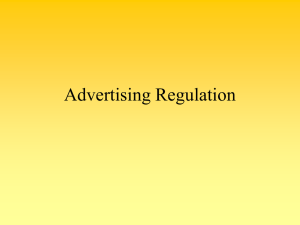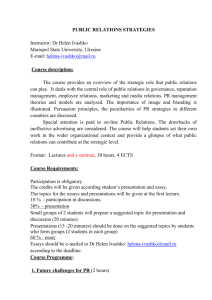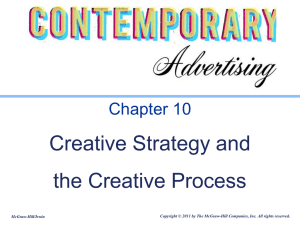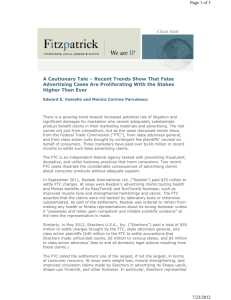ETHICS, REGULATION AND SOCIAL RESPONSIBILITY
advertisement
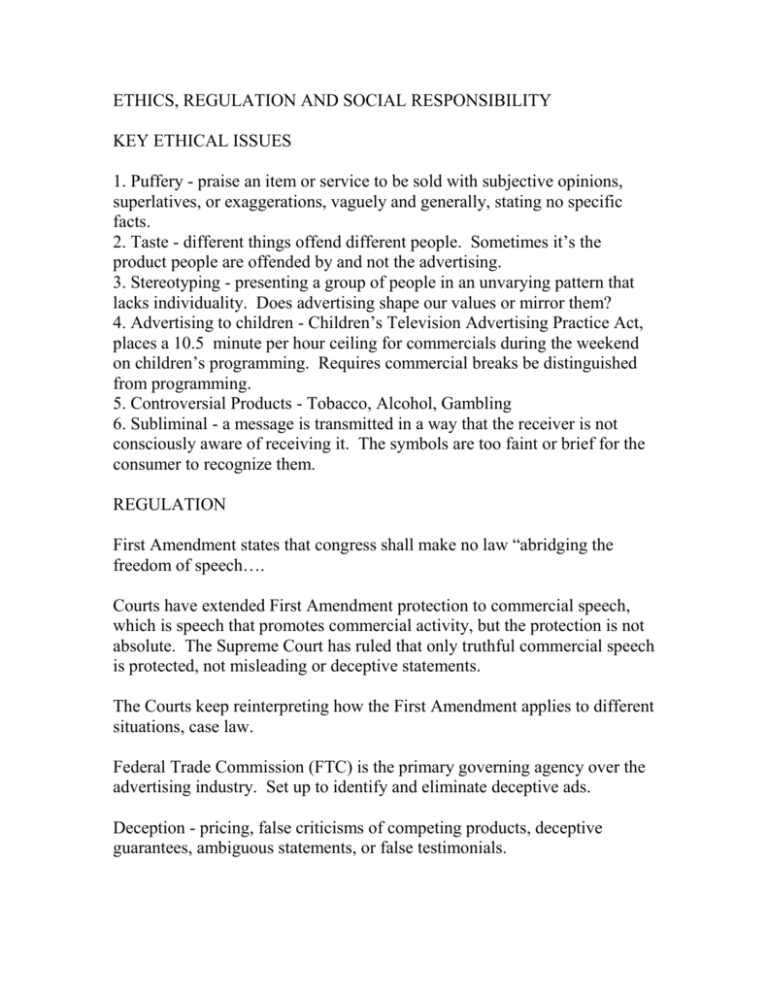
ETHICS, REGULATION AND SOCIAL RESPONSIBILITY KEY ETHICAL ISSUES 1. Puffery - praise an item or service to be sold with subjective opinions, superlatives, or exaggerations, vaguely and generally, stating no specific facts. 2. Taste - different things offend different people. Sometimes it’s the product people are offended by and not the advertising. 3. Stereotyping - presenting a group of people in an unvarying pattern that lacks individuality. Does advertising shape our values or mirror them? 4. Advertising to children - Children’s Television Advertising Practice Act, places a 10.5 minute per hour ceiling for commercials during the weekend on children’s programming. Requires commercial breaks be distinguished from programming. 5. Controversial Products - Tobacco, Alcohol, Gambling 6. Subliminal - a message is transmitted in a way that the receiver is not consciously aware of receiving it. The symbols are too faint or brief for the consumer to recognize them. REGULATION First Amendment states that congress shall make no law “abridging the freedom of speech…. Courts have extended First Amendment protection to commercial speech, which is speech that promotes commercial activity, but the protection is not absolute. The Supreme Court has ruled that only truthful commercial speech is protected, not misleading or deceptive statements. The Courts keep reinterpreting how the First Amendment applies to different situations, case law. Federal Trade Commission (FTC) is the primary governing agency over the advertising industry. Set up to identify and eliminate deceptive ads. Deception - pricing, false criticisms of competing products, deceptive guarantees, ambiguous statements, or false testimonials. Terminology Endorsement or testimonials - using a spokesperson or statements from a person/s who consumers believe reflects the opinions or beliefs of that person. Product placements - use brand name items in movies or on TV Consent decree - The FTC notifies the advertiser and asks the advertiser to sign a consent decree agreeing to stop the deceptive practice. Cease-and-desist order - when an advertiser refuses to sign consent decree the FTC holds a commission similar to a court trial. Corrective advertising - when consumer research determines that an ad campaign has perpetuated lasting false beliefs, the FTC can order advertising be created to correct the false impression. FTC can require advertisers to validate any claim FTC can order a refund, return of property, payment of damages FTC can hold an advertising agency accountable if they had reason to know it was false or deceptive. OTHER REGULATORY AGENCIES Food and Drug Administration (FDA) - packaging, labeling of food and drug products Federal Communication Commission -regulates radio and tv US Postal Service - monitors materials sent through the mail Bureau of Alcohol, Tobacco and Firearms - regulates advertising for alcoholic beverages US Patent Office - Oversees trademarks Library of Congress- copyright protection INDUSTRY SELF REGULATION National Advertising Review Council - National Advertising Division (NAD) and National advertising Review Board (NARB) Media Regulation - screening and rejecting ads that violate their standards SOCIAL RESPONSIBILITY Advertising can be used in a positive way as a tool to improve society. PSA’s - Public Service Announcements The Ad Council - a private, nonprofit organization that includes advertising agencies and media that adopt good causes and develop free advertising campaigns on their behalf. Social Marketing - companies, government agencies and nonprofit organizations can also use advertising to communicate about their social programs. Most agencies, and in-house marketing departments follow a business model: The companies task is to determine the needs, wants and interests of target markets and to deliver the desired satisfactions more effectively, efficiently than it’s competitors in a manner that is non offensive to the target market. THE MARKETING PROCESS Marketing is the process of planning and executing the conception, pricing, promotion, and distribution of ideas, goods and services to create exchanges that satisfy the perceived needs, wants and objectives of the target audience. Marketing Mix - blend of activities such as designing the product and its package, pricing, distribution and promotion Business Plan - encompasses the whole business and answers how a business is going to make money. Marketing Plan - encompasses the marketing mix 1.Product - includes design and development, branding and packaging 2. Distribution - includes the channels used in moving and storing the product from the manufacturer to the buyer 3. Price - includes the price at which the product or service is offered for sale 4. Promotion or marketing communication - includes personal selling, advertising, public relations, sales promotion, direct marketing, point of sale, packaging and outdoor. Terminology Branding - makes a product distinctive in the marketplace. A brand is the name, term, design, symbol, etc. The brand name can be spoken. Brand equity is the reputation the name or symbol connotes. Marketing Communications plan/mix - blueprint of marketing communications activity To plan marketing communication effectively, marketers must understand the strengths and weaknesses of each marketing communications tool/technique. Advertising is a tool in the promotion part of the marketing mix. Advertising Strengths 1. Can reach a mass audience 2. Introduces new products/services 3. Explain changes in a product or service 4. Reminds and reinforces 5. Persuades MARKETS Market is either a region where goods are sold and bought or a particular type of buyer. Four Main Types of Markets are: 1. Consumer 2. Business-to-Business- use in own business or to make other products 3. Institutional - schools/hospitals/non profits 4. Reseller markets - wholesalers, retailers, distributors Terminology Product differentiation - marketing strategy designed to create product differences in the minds of the consumers that distinguish the company’s product from all others. Image - implies a difference Positioning - is the process of determining what place a product should occupy in the target market’s mind. You can position by: 1. Price - high, low, medium 2. Attributes - Vortex offers a quiet heater 3. Ability to surpass the competition 4. Application - Tylenol flu is for flu attacks 5. Product User - teens, seniors, children, etc 6. By product class - Starbucks is a coffee The role of the marketing and advertising strategy is to relate the product’s position to the target market. AD AGENCIES Full Service Agency - includes the four major staff functions: 1. Account Management - liaison between client and agency 2. Creative Services - copywriter, artists, producers 3. Media Planning and Buying 4. Account Planning/Research - gathers intelligence on market, competitors, consumers 5. Internal Services - billing, personnel Specialized Agencies - specialize 1. Functions - creative or media buying 2. Audience - youth, minority 3. Industry - healthcare, automotive, business-to-business 4. Direct marketing 5. Public Relations 6. Sports marketing 7 Events marketing 8. Single client agencies Agencies are paid through a combination of fees and commissions


